2016 lagged prior years’ growth

Download this blog
Download PDF›

Download data by jurisdiction
Download Excel File ›
In 2016, the Washington region had 6,131,977 residents, an increase of 53,508 (+0.9 percent) from 2015. Population growth in 2016 was the smallest in the past six years and below the 1990-2015 average growth rate of 1.5 percent. Net domestic migration has been increasingly negative since 2014, pulling down overall growth. The Washington region had middling population growth compared to the 15 largest employment metros and ranked eighth in terms of growth in 2016. Metros with higher growth had positive domestic migration, which frequently results from comparatively high employment gains.
Population growth in every sub-state area was lower in 2016 when compared to 2015 and the overall growth trend has been downward since 2010, when it reached a nine-year high and grew by 2.1 percent. Within the sub-state areas, the District had the highest population growth in 2016, rising by 1.6 percent. Population growth in the District in 2016 exceeded that in 2014 and in all years between 1990 and 2008, and it continues to show relative strength. Northern Virginia’s population growth stabilized somewhat in 2016 (+0.97%) and was only modestly different from 2015 (+1.00%) and 2014 (+1.03%). However, growth in 2016 in Northern Virginia was the lowest of any year going back to 1990. Suburban Maryland’s population increased 0.6 percent, the lowest of the sub-state areas, and registered its smallest growth since 2007.
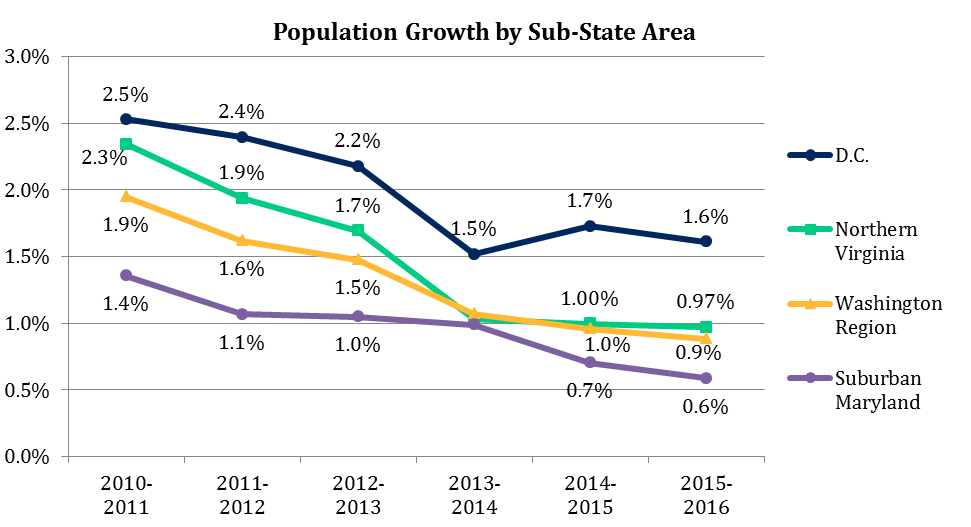
The slowdown in population growth has been driven by a shift in net domestic migration. In 2011, 22,979 more people moved into the region from elsewhere in the U.S. than moved out, a rate of 4.0 residents per 1,000 residents. In the following two years, net domestic migration was subdued but remained positive, adding 5,525 residents in 2012 (a rate of 0.9) and 3,827 residents in 2013 (a rate of 0.6). In 2014, more residents in the Washington region migrated to other parts of the U.S. than moved in, resulting in a loss of 26,360 net residents (a rate of -4.4). Net domestic migration has continued to decline and the region lost 31,010 residents in 2016 because domestic outmigration (a rate of -5.1).
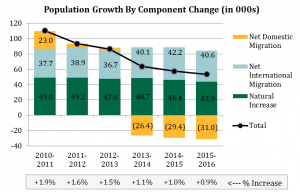
Net international migration has been a continued source of population growth in the past six years. The region gained 40,581 residents as a result of net international migration, a rate of 6.6. Net international migration rates were between 6.2 and 7.0 over the past six years and this component was the most stable for the region during this time.
Similarly, the natural increase, or births minus deaths, has been the largest source of growth for the region going back to 2010. Because of the net domestic out-migration, it has grown as a share of overall growth and accounted for 82.0 percent of the net gains in 2016. In 2011, only 44.4 percent of the region’s growth was from the natural increase.
How Do Jurisdictions in the Region Vary?
Within the region, population growth ranged from 3.0 percent in Loudoun to -0.3 percent in Manassas City in 2016. Loudoun County led in both the percentage gains and the absolute gains and added 11,386 residents in 2016. The District had the second largest absolute increase (+10,793), followed by Montgomery County (+7,630). The second largest percentage growth occurred in Fairfax City (+1.9%), followed by Stafford County (+1.8%). Only two jurisdictions had population declines in 2016. Rappahannock County lost just 13 residents (-0.2%), while Manassas City had 120 fewer residents (-0.3%) in 2016 compared to 2015.
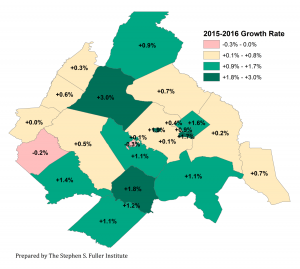
The drivers of change by jurisdiction were also varied in 2016. The natural increase was not a consistent source of growth throughout the region; Rappahannock County, Manassas City and Clarke County had more deaths than births, resulting in population losses in the natural increase component. The highest birth rates were in Fairfax City (29.2 births per 1,000 residents), Falls Church City (20.0) and Alexandria City (18.3). Relatively fewer deaths occurred in Manassas Park City (2.6 per 1,000 residents), Loudoun County (3.7) and Manassas City (4.0). Combined, the rates of natural increase were relatively high in Fairfax City (18.8), Falls Church City (14.4) and Manassas City (14.0).
Every jurisdiction in the region added residents as a result of net international migration. The increase ranged from just one person in Rappahannock County to an increase of 9,919 residents in Fairfax County. After normalizing for the population size, Alexandria City had the highest rate of net international migration and added 14.0 residents per 1,000 people as a result of this component. Falls Church City had a rate of 9.4 and Montgomery County had a rate of 9.2, ranking second and third highest, respectively.
Net domestic migration was negative for 13 of the 24 jurisdictions in the Washington region. The largest absolute loss occurred in Fairfax County, which had 17,820 more residents move to other parts of the region or the U.S. than move in. The largest absolute gained was in Loudoun County, which added 4,902 residents as a result of net domestic migration. After normalizing for population size, the largest losses were in Manassas City, Falls Church City and Fairfax County. The largest relative gains were in Loudoun, Culpeper and Stafford counties.
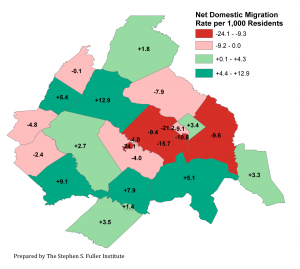
How Does the Washington Region Compare to Other Metros?
The Washington region ranked in the middle of the 15 largest employment metros in terms of population growth in 2016, at eighth (highest and lowest). The region has ranked eighth since 2014. In 2011, the Washington region had the second highest population growth.
Phoenix led the metros for population growth, rising 2.1 percent between 2015 and 2016. The largest absolute gain occurred in Dallas, which added 143,435 residents. Only one metro had population declines and the number of residents in Chicago fell by 19,570 (0.2%). The population in the Detroit metro seems to have stabilized, rising by 79 residents in 2016 and has had a growth rate between -0.1 percent and +0.1 percent per year since 2010.
Net domestic migration was positive for the five metros with the fastest population growth in 2016. Conversely, metros with higher rates of domestic outmigration had comparatively weak overall population growth rates. Metros with domestic in-migration have had relatively strong recent job growth over the past few years as domestic migration is more sensitive to employment growth than the other components of change.
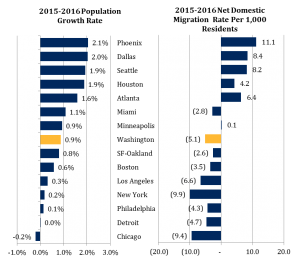
About These Data
The 2013 metro region delineations are used throughout for all metros and all years. Estimates are as of July 1 for every year. 2010-2016 data are from the Vintage 2016 Population Estimates from the U.S. Census, released March 23, 2017. Data prior to 2010 are from the Intercensal Population Estimates (1990-2000 and 2000-2010).
